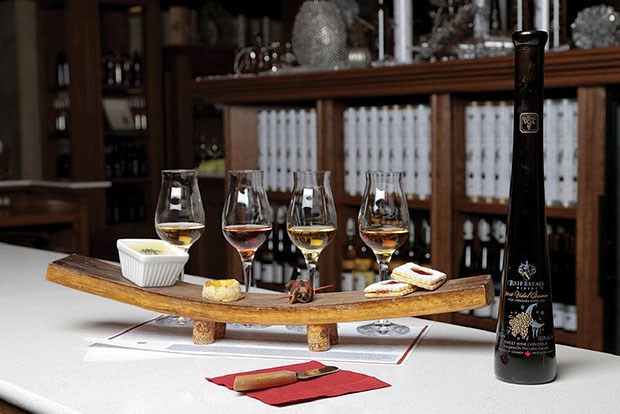The snow and chilly temperatures set a perfect winter scene in beautiful Niagara-on-the Lake, as my wife and I bundle ourselves in parkas, mitts and wool hats. We set off from our B&B towards Queen Street, wandering past snow-draped vineyards, the region's famous grapes seemingly asleep under a white shroud.
We trek into the town's historic downtown. Our plan is to sample the best offerings from the region's 28 wineries, to enjoy the wine, food and live entertainment and to learn more about Niagara's liquid gold.
Rather than going into hibernation through the icy months, we have found various ways to celebrate winter. There is hockey, of course, and skiing, curling, dog sledding and snowshoeing. And then there is icewine.
Every January, when the temperatures drop, select Niagara winemakers gather their crews and venture into the vineyards in the middle of the night to handpick the frozen grapes. Then, to celebrate their good fortune, they welcome visitors from all around to sample the region's unique winter wine, paired with the local cuisine.
Heading into its 19th year, the Annual Niagara Icewine Festival is a uniquely Canadian winter experience, an outdoor street festival with live music, gala dinners, ice sculptures, icewine marshmallows to roast over open fires and lots of icewine tastings to help warm you.
We move around sampling the icewine offerings from area wineries, while enjoying savoury and sweet treats from local restaurants.
Often touted as Canada's greatest liquid luxury, icewine is made in only three countries, and undoubtedly made best here, which is why we have become the world's leading producer. More than any nation, we have the right climate. Our growing conditions combine warm summers with cold winters, allowing Canadian winemakers to reap the benefits of this special winter harvest.
The grapes for icewine are picked at temperatures of at least -8°C so only the highly concentrated juice is pressed from the frozen berries, leaving behind the icy water crystals. The result of these unique climatic conditions is a deliciously sweet wine, with intense flavours and aromas, and an exceptionally high concentration of sugars, acids and extracts from the grapes.
Admission is free for the Niagara-on-the-Lake festival, where the town's main street has been transformed into an icewine village. We stop to marvel at the ice sculptures, many, this year, with a War of 1812 theme.
There is a Flash & Panache Icewine Cocktail Competition where shaken, stirred, mixed and occasionally muddled concoctions are thrown together by local mixologists.
My wife's fingers and toes are beginning to freeze, so we pick up a festival discovery pass and venture inside the wineries to experience wine pairings in a warmer, cosier atmosphere. The pass ($40) includes eight wine pairings, with a mocktail and food pass ($30) available for "designated" drivers. Thank goodness, my wife and I had chosen to walk, helping to avoid a marital spat.
Visitors looking to learn more about icewine can sign up for a tasting class. I was treated to an enlightening pairing class at Reif Estate Winery, where I learned the proper technique for savouring every sip - let the wine linger on your tongue.
You haven't really experienced winter's rare gift until you have enjoyed it outdoors in sub-zero temperatures. It's just so Canadian. Travel Writers' Tales is an independent travel article syndicate.



